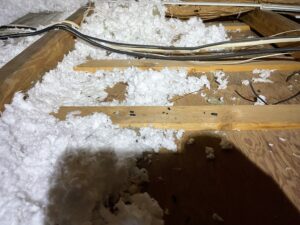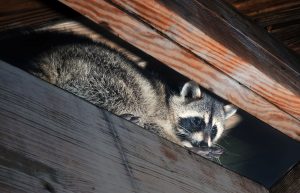Get Rid of Animals from Your Home
When an animal enters your home, it is more than a simple nuisance. Invading animals can wreak havoc on your quality of life and your property. Usually, you can identify an unwanted animal guest from the noise or the smell, but greater risks lurk undetected.
Animals make a lot of noise — scratching, scampering, stomping, squeaking, clicking, shrieking, and a host of other noises. Depending on what time you hear the noise can help identify the critter. Loud noises at night are usually raccoons. Scampering in the morning is usually associated with squirrels.
Not only do animals bring the noise, but they also damage your property. Rodents sharpen their teeth on wood beams and electrical wires. The insulation in your attic makes perfect materials for a raccoon’s nest.
Many wild animals can carry diseases and parasites that can be transmitted to humans. Animal waste poses risks to your health especially if it collects in one area. Raccoons establish latrine sites, and bat guano collects where they roost. Finally, if an animal does die in your home, the decaying body will release harmful bacteria and a powerful odor.
If you suspect an animal has taken up residence in your home, contact a professional for an inspection immediately.
Animals in Attic
Since they’re warm and often undisturbed by humans, attics make great nesting options for many unwanted critters. Most often these pests seek shelter in attics to survive harsh weather during winter or raise young during the spring.
Common attic invaders, such as squirrels, mice, rats, raccoons, birds, and bats, all find different ways into homes depending on their dexterity and size.
- Small rodents, like mice and rats, are capable of squeezing through gaps as small as half an inch wide.
- Squirrels and raccoons are excellent climbers and can shimmy up drain spouts or jump from overhanging tree branches to reach attics.
- Birds and bats have an easier time gaining access since they can simply fly through unsecured openings in building exteriors.
Thankfully, none of these nuisances are particularly stealthy, and homeowners will be alerted to their presence through warning signs such as excessive scratching in the attic.
Is There an Animal in My Wall?
When infestations of squirrels, raccoons, rats, mice, and even birds are present in homes, individual animals can find their way into some inconvenient hiding places. For example, these animals often get trapped in wall cavities.
Irritating sounds and unpleasant odors are the biggest indicators that animals are in the walls. When pests get trapped, they are likely to scratch at their surroundings and vocalize in their panic. Scampering, clicking, and whimpering are just some of the sounds homeowners are likely to hear.
Though they rarely seek out the voids in walls as places to construct nests, critters fall into these spaces via exterior holes in buildings, air ducts, and piping. Having animals in the walls of a home is detrimental to the building itself, the trapped pests, and the human residents.
The smell of excrement or, given the worst-case scenario, decaying flesh also points to a present pest infestation. Additionally, individuals should look for droppings around the home and holes in the wall that appear to be the result of excessive gnawing.
As such, it is important to identify and remove these animals before the problem escalates. Property owners are likely to find one of two common rodent invaders in their walls: the Norway rat or the house mouse.
The Dangers of Animals in Your House
Animals in your walls or your attic are a problem because they cause structural damage to the home, foul the attic with their waste, and contaminate the house with diseases and parasites.
Rabies, salmonellosis, plague, rat-bite fever, Histoplasmosis, and raccoon roundworm can be transmitted to humans by animals living in your home.
Animal urine is malodorous and stains walls and ceilings. The accumulation of excrement around homes spreads different diseases such as Histoplasmosis.
Rodents are compelled to constantly chew on wooden beams and electrical wires, which can cause fires. Many animals will readily tear up the insulation in attics to use in the construction of nests.
Animals trapped in walls try desperately to escape and often weaken the structural integrity of buildings in the process. Finally, if pests aren’t removed from wall cavities in time, they die. Not only does their death bring unpleasant odors, but it also attracts other nuisances like flies and beetles.
Wildlife Removal from Your Home
Homeowners should never attempt to handle wild animals. Given all the unpleasant and dangerous side effects, homeowners are encouraged to call professional wildlife removal services at the first sign of infestation. Trained specialists have access to the necessary tools and knowledge to eradicate pest populations. Additionally, professionals are able to properly sanitize affected areas so that homes are safe for human inhabitants once again.

Is It Bad to Have an Animal in the Attic?
It is not good to have an animal in your attic. Animals damage your house, upset your life, and spread diseases. Attics are the quintessential Read More »

Animal Damage in Tampa Attics
Pest animals in Tampa seeking shelter in attics is a common issue faced by homeowners. Unexpected noises from the attic are a sure sign that Read More »

Squirrel Nest Removal
Squirrels build their nests (also called dreys) in shelter locations high above the ground. Typically they are built inside tree cavities or between large tree Read More »

Raccoon in Attic in Flower Mound
A homeowner in Flower Mound heard loud thumping noises in the middle of the night. They investigated their attic and found dark, tubular droppings. During Read More »

Seven Signs of an Animal in Attic
Since they’re warm and often undisturbed by humans, attics make great nesting options for many unwanted critters. Most often these pests seek shelter in attics Read More »


